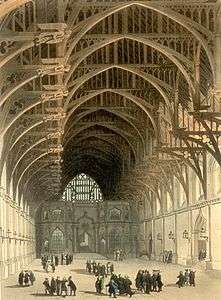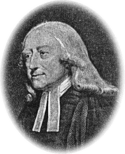Sidney Hill Cottage Homes
Sidney Hill Cottage Homes, whose official name is Sidney Hill Churchill Wesleyan Cottage Homes, is a Grade II listed Wesleyan almshouse in the village of Churchill in North Somerset. It was opened in December 1907 to provide furnished accommodation for people in need. Designed in an Arts and Crafts Vernacular style by Thomas Ball Silcock and Samuel Sebastian Reay FRIBA of Silcock and Reay, architects at Bath and London, twelve cottages were constructed on three sides of a quadrangle, with landscaped gardens. The third, or south side, is enclosed by a low terrace wall with wrought iron gates. A large stone sundial, with a spreading base, is set in the centre of the quadrangle. In their original form, each house had a living room, with a small scullery, larder, coal house, and one bedroom with a large storeroom.
| Sidney Hill Cottage Homes | |
|---|---|
 Pathway leading to the front of the cottage homes | |
 Location within Somerset | |
| Alternative names | The Sidney Hill Churchill Wesleyan Cottage Homes |
| General information | |
| Type | Wesleyan almshouse |
| Architectural style | Arts and Crafts Vernacular style |
| Location | Front Street, Churchill, North Somerset, England |
| Coordinates | 51.335258°N 2.804740°W |
| Construction started | 1906 |
| Inaugurated | December 1907 |
| Client | Sidney Hill |
| Governing body | Charity Commission. The Sidney Hill Churchill Wesleyan Cottage Homes, registered charity no. 201051. |
| Design and construction | |
| Architect | Thomas Ball Silcock and Samuel Sebastian Reay FRIBA of Silcock and Reay, architects at Bath and London |
| Main contractor | Isaac Ford and Sons, Cheddar, Somerset |
Listed Building – Grade II | |
| Official name | Sidney Hill Cottage Homes and attached gatepiers, walls and gates |
| Designated | 19 January 1987 |
| Reference no. | 1129199 |
Sidney Hill, a wealthy local businessman and benefactor, paid for the construction costs and endowed a fund to maintain the homes. Sidney Hill Churchill Wesleyan Cottage Homes, a registered charitable trust and a member of the National Association of Almshouses, continues to manage the homes and provide accommodation for local people in need. The trust also funds the maintenance of the communal garden and operates the heating system which services the houses.
History

On 12 May 1904, Sidney Hill purchased at auction a plot of pasture and arable land in Churchill called The Vicarage Close for £500.[1] The plot contained 2.29 hectares (5 acres 2 roods 26 perches) that consisted of three lots numbered 166, 168, and 169 on the Churchill tithe map.[2][lower-alpha 1].Hill's intention was to build a furnished almshouse on Vicarage Close for people of advanced years, in difficult circumstances, and without near relatives.[4] This would be Hill's second almshouse after he built and furnished six dwellings known as the Victoria Jubilee Homes at Langford in commemoration of the Golden Jubilee of Queen Victoria.[5]
The homes in Churchill were built by Isaac Ford and Sons of Cheddar, to an Arts and Crafts design by the architects Thomas Ball Silcock and Samuel Sebastian Reay FRIBA of Silcock and Reay, at Bath and London.[6] Sidney Hill and Silcock were political allies: Hill was a vice-president of the Liberal Association in Wells and nominated Silcock as the Liberal candidate for the 1906 General Election.[7] Silcock and Reay's coloured drawing of the homes was sufficiently well-regarded to be included in the 1906 and 1907 Royal Academy Exhibitions.[8][lower-alpha 2]
The cost of the buildings, exclusive of the cost of land, amounted to £11,000, and the furniture in the homes, the trustees' room, and the matron's cottage, amounted to a further £1,915. The gardens and planting cost an additional £900.[10] The homes bear the inscription "The Sidney Hill Churchill Wesleyan Cottage Homes" and were opened in December 1907. The first residents were chosen personally by Sidney Hill with preference given to followers of the Wesleyan movement.[11] Robert Stone, a blacksmith at the forge opposite the homes, had a cottage where the homes were built. The cottage was demolished during construction, and he and his wife became the first family to enter the homes.[12] Each occupant of the homes was given a sufficient weekly sum for maintenance.[6][lower-alpha 3]
On 13 January 1908, John Durban Loveless, Sidney Hill's agent,[lower-alpha 4] was presented with an illuminated address and silver salver by Silock and Reay in recognition of his efforts to complete the home. The presentation was made by Silcock, then the Liberal MP for the Wells Division of Somerset, and the address was designed and illuminated by Reay.[14] The land and buildings were gifted to the Sidney Hill Churchill Wesleyan Cottage Homes trust in October 1906.[15] After the death of Sidney Hill in 1908, and four years after the death of his nephew who had succeeded him, Thomas Sidney Hill, his great nephew took over as chairman of the trust. Since that time various other local people have been nominated to the board of trustees including, up until this day, many direct descendants of the Hill family.[16]
In 1958, the trust became a member of the National Association of Almshouses, and in January 1962, a registered charitable trust.[17] The occupants were not asked to make a residential contribution until 1972, and since that time, there have been annual increases; now a contribution is made which is comparable with modern rented accommodation.[16] The trust also funds the maintenance of the communal garden and operates the heating system which services the houses.[18]
Architecture
The houses stand on land containing 0.61 hectares (1.5 acres), elevated about 1.5 metres (5 feet) above Front Street in Churchill, with a field of 1.6 hectares (4 acres) south of the main buildings and reserved in perpetuity as an open space.[20][lower-alpha 5] They are arranged on three sides of a quadrangle about 37 metres (120 feet) square, its open side facing south with a view to woods on the Mendip Hills.[21] The south side is enclosed by a low brick terrace wall coped with stone and ornamented with carved stone vases, and in the centre is a gateway with wrought iron gates giving access to working gardens. Wide stone-paved paths run round the four sides of the quadrangle, the south path is terminated at each end with a large arbour arranged under the main roof, which is supported by oak posts and balustrades, each arbour contained oak seats and tables.[20]
A low, brick parapet wall encloses the quadrangle, with stone steps leading down to the lawn and flower borders; these are sunk some 0.76 metres (2.5 feet) below the level of the stone paved paths, and in the centre is a large stone sundial (see §Sundial). The front of the building faces Front Street in Churchill, and is set back from the road by a courtyard that has lawns and paths with flower borders and trees. A terrace wall of brick with large stone vases separates the courtyard from the road. The courtyard is approached by steps through entrance gates made of wrought iron with a bell turret and weather vane over the central archway.[22]
The north, east, and west sides of the houses have gables and recessed arbours that have arches supported by oak posts.[lower-alpha 6] The doorways are constructed from arched oak frames and doors; the doors in the quadrangle have moulded hoods supported by carved corbels. The walls are of sand-faced brick, with handmade red roof tiles, oak window frames with iron casements and lead window glazing.[21] The stone used for the copings, piers and finials is Cotswold stone, a yellow, oolitic Jurassic limestone, that was mined at Temple Guiting quarry, in Gloucestershire, England.[6] It was chosen as its colour would harmonise with the warm tones of the walls and roofs.[23]
In the original design, each house had a living room, with a small scullery, larder, coal house, and a bedroom with a large storeroom. Over the entrance to the quadrangle is a large meeting room, reached by a spiral stone staircase. The room is panelled to a height of 2.1 metres (7 feet), with windows at each end, on which are the coat of arms of Sidney Hill.[24][lower-alpha 7] The room also has a stone fireplace with Hill's motto inscribed on the mantelpiece.[10][lower-alpha 8] The living rooms in the homes had fireplaces set in golden brown bricks with raised hearths of the same material.[25] The bedroom fireplaces had green tile surrounds and tiled hearths, and all the fireplaces had simple oak mantels.[10] A fire guard was provided for each living-room, and bells enabled each house to communicate with the others in case of emergency.[lower-alpha 9] The homes were furnished with oak furniture designed by Silcock and Reay. In the south-west corner of the site a small laundry was built together with outbuildings.[10]
Sundial
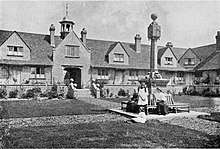
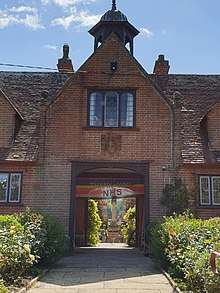
A large stone sundial, designed by Silcock and Reay, stands on a base of brick in the centre of the quadrangle, and is listed separately as a Grade II monument by Historic England. It has a limestone mid course and cornice, and a hexagonal stone shaft 4.5 metres (15 feet) metres high, developing from four consoles that have decorative features in lead. A square sundial, with four bronze plates and a ball finial, are affixed to the top of the shaft.[27][28] The four brass plates bear the following:
| Direction | Description | Notes | Ref. |
|---|---|---|---|
| North | Arms of Sidney Hill | According to Fox-Davies in Armorial Families (1895), Hill bore:[29]
|
[30] |
| East | Motto of of Sidney Hill | Stone in The Routledge Dictionary of Latin Quotations (2005), translates the motto, Omne bonum Dei donum, as "Every good thing is a gift of God" and is taken from James, chapter 1, verse 17.[lower-alpha 10] | [31] |
| South | Vertical sundial | John Parish White and Sons of The Pyghtle Works, Bedford, supplied the sundial, decorative lead, stonework and plates. The same company supplied the oak benches that surrounded the base when it was first erected.[lower-alpha 11] | [28][33] |
| West | Initials of Sidney Hill and the date of construction (1907) | "SH/1907" is inscribed on the plate. | [28] |
There are also four brass bronze plates attached around the base of the sundial that inscribe a quatrain of John Greenleaf Whittier, called Inscription on a Sun-Dial for Dr. Henry I. Bowditch.[34] Whittier wrote the quatrain originally as an inscription for a sundial plate owned by Dr. Henry Ingersoll Bowditch.[35][lower-alpha 12]
With warning hand I mark Time’s rapid flight
From Life’s glad morning to its solemn night;
Yet, through the dear God’s love, I also show
There’s Light above me by the shade below.
Matron's house
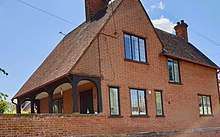
A matron's house was built in the north-west corner of the site, adjoining Front Street, containing two sitting-rooms, a kitchen, three bedrooms, and a bath-room.[10] The matron's house is listed as a Grade II building by Historic England separately from the other buildings on the site.[36] It is one storey building, with a (now converted) attic, constructed from red brick with a plain tiled roof. The windows have three wooden casements with small leaded-panes; those to the attic are under gables. There are two Tudor-arched doorways with plank doors to south and east fronts. There is a wooden round-arched loggia to the east front and a gabled porch to the south front.[36][37]
Architectural importance
There is no overarching architectural style within Churchill. However, the Sidney Hill Cottage Homes is unique within the village, with its ornate brick work, ironwork railings and lampposts, large concrete urns, bell tower and weather vane, and in the central courtyard, the sundial.[38] In particular, the gate piers with their carved stone vases and wrought iron gates are an exciting testimony to late Victorian architecture.[12]
In contrast, the predominant construction material in the larger, detached Georgian buildings is local stone, interspersed with much older, more traditional cottages, and post-war, detached bungalows and houses.[39] There are a few other structures with distinctive brickwork features in the area that include the Jubilee Clock Tower and Methodist Church.[38][lower-alpha 13]
References
- Bristol Times and Mirror 1904, p. 9, May 14.
- Western Daily Press 1904, p. 1, May 7.
- Ecclesiastical Commissioners 1876, p. 2; Bristol Mercury 1876, p. 1, July 1.
- Morris 2009, p. 172.
- Leeming 1977, p. 41.
- Western Daily Press 1907, p. 7, February 20.
- Weston-super-Mare Gazette 1886, p. 3, May 22; Shepton Mallet Journal 1906, p. 5, January 19.
- Leeming 1977, p. 42; Royal Academy of Arts 1907, p. 98.
- Royal Academy of Arts 1907, p. 98.
- Macartney 1909, p. 306.
- Weston-super-Mare Gazette 1908, p. 8, March 7.
- Leeming 1977, p. 42.
- Central Somerset Gazette 1933, p. 6, January 20.
- Wells Journal 1906, p. 5, January 18.
- Archer 2009, p. 240.
- Morris 2009, p. 173.
- Morris 2009, p. 173; Sidney Hill Cottage Homes 1962.
- Sidney Hill Cottage Homes 1962.
- Statham 1906, p. 723, June 30; Statham 1907, p. 273; Tate 2004.
- Macartney 1909, pp. 302–305.
- Holme 1909, p. 218.
- Macartney 1909, p. 305; Holme 1909, p. 218.
- Jones, Gill & Watson 2006, p. 34; Macartney 1909, p. 306.
- Holme 1909, p. 218,220.
- Holme 1909, p. 220.
- Walker 2018, p. 2.
- Macartney 1909, p. 305.
- Historic England, "Sundial in inner courtyard at Sidney Hill Cottage Homes (1157960)", National Heritage List for England, retrieved 7 June 2020
- Fox-Davies 1895, p. 500.
- Bedfordshire Times and Independent 1907, p. 3, October 18.
- Stone 2005, p. 189; Bible Hub 2020.
- London Evening Standard 1909, p. 51, May 13; White 1915, pp. 54–69.
- Macartney 1909, p. 305; Bedfordshire Times and Independent 1907, p. 3, October 18.
- Taunton Courier 1934, p. 10, August 29; Whittier 1892, p. 322.
- Bowditch 1902, pp. 240–246, Chapter 12. Life at Weston. The Whittier Sundial
- Historic England, "Matron's House at Sidney Hill Cottage Homes (1320947)", National Heritage List for England, retrieved 19 June 2020
- North Somerset Council 2019, p. 10.
- North Somerset Council 2019, p. 9.
- North Somerset Council 2019, p. 8.
- Royal Institute of British Architects 1917, p. 120; Weston Mercury 1881, p. 2, May 14.
Footnotes
- The land was former glebe under the Dean and Chapter of Bristol. The Ecclesiastical Commissioners for England sell the land for the first time on 7 July 1876. See also chancel repair liability.[3]
- See exhibit 1570, The Churchill Homes, Somerset: Front view. Silcock and Reay in the 1907 catalogue.[9]
- The founding deed stated that the private income of any occupant was not to exceed £50 per year.[4]
- Loveless was an agent and steward for Sidney Hill and a lay preacher in Wesleyan churches in the North Mendip area.[13]
- However, see rule against perpetuities.
- See Courtyard with an Arbour for architectural influences.
- The meeting room is used by the trustees of The Sidney Hill Churchill Wesleyan Cottage Homes charity.[10]
- See §Sundial for Hill's coat of arms and motto.
- The heating system has now been replaced by a central, oil-fired system which services all the houses.[26]
- For an image of the Hill arms, see (Fox-Davies 1895, p. 1265), image 5, plate 92.
- John Parish White established the Pyghtle Works, Bedford, in 1896, where he produced an extensive range of garden statues, vases, sundials, and fountains.[32]
- See (Bowditch 1902, p. 246, Chapter 12). Life at Weston: The Whittier Sundial, for an illustration of the sundial plate owned by Henry Ingersoll Bowditch.
- It is notable that the clock tower and Methodist church were built by Sidney Hill. However, Foster and Wood, Bristol, were the architects for these two buildings, and were known for their Gothic style.[40] See the philanthropic works of Sidney Hill for more information.
Bibliography
Books and journals
- Archer, Peter (2009). "25. Simon Sidney Hill". In Fryer, Jo; Gowar, John; et al. (eds.). More Stories From Langford: History and tales of houses and families. Lower Langford: Langford History Group. pp. 233–246. ISBN 978-0-9562253-1-3. OCLC 743449641.
- Bowditch, Vincent Yardley (1902). "12. Life at Weston: The Whittier Sun-dial". Life and Correspondence of Henry Ingersoll Bowditch. Henry Ingersoll Bowditch. Boston: The Riverside Press. pp. 240–246. OCLC 1048321838. Retrieved 16 June 2020.
- Fox-Davies, Arthur Charles (1895). Armorial Families. A complete peerage, baronetage, and knightage, and a directory of some gentlemen of coat-armour, and being the first attempt to show which arms in use at the moment are borne by legal authority. Edinburgh: T. C. and E. C. Jack, Grange Publishing Works. hdl:2027/coo1.ark:/13960/t0bv81w2k. OCLC 3588083.
- Holme, Charles, ed. (1907). International Studio an Illustrated Magazine of Fine and Applied Art. March to June 1907. Numbers 145 to 148. 31. New York: John Lane Co. pp. 121–124. OCLC 1046964405. Retrieved 15 June 2020.
- Holme, Charles, ed. (1909). International Studio an Illustrated Magazine of Fine and Applied Art. March to June 1909. Numbers 145 to 148. 37. New York: John Lane Co. pp. 217–221. OCLC 1046964405. Retrieved 1 June 2020.
- Jones, D. I. E; Gill, H.; Watson, J. L. (2006). Spon's quarry guide to the British hard rock industry. London: E. and F. N. Spon. ISBN 978-0-419-16710-5. OCLC 468321355. Retrieved 18 June 2020.
- Leeming, Charles Frederick (1977). Langley, Peter (ed.). Langford and Churchill Guide. Sir John Wills. Churchill: Cliftonprint. OCLC 852053375.
- Macartney, Sir Mervyn Edmund, ed. (June 1909). "The Churchill Cottage Homes". The Practical Exemplar of Architecture. Being Fine examples of Architectural Details. January to June 1909. London: The Architectural Review, Caxton House, Westminster. 25 (24): 302–307. OCLC 679869000. Retrieved 16 June 2020.
- Morris, Joy (2009). "20. The Victoria Jubilee Homes". In Fryer, Jo; Gowar, John; et al. (eds.). Every house tells a story: A history of some of Langford's older houses and the people who lived in them. Lower Langford: Langford History Group. pp. 171–174. ISBN 978-0-9562253-0-6. OCLC 751457329.
- North Somerset Council (2019). Conservation Area Appraisal and Management Plan (PDF) (Report). Churchill. Archived (PDF) from the original on 15 May 2020. Retrieved 19 June 2020.
- Royal Academy of Arts (1907). The exhibition of the Royal Acadeny of Arts 1907: The 139th. London: William Clowes and Sons, Limited. OCLC 1045219526. Retrieved 15 June 2020.
- Royal Institute of British Architects (March 1917). "Journal of the Royal Institute of British Architects. Joseph Foster Wood: Memoir". Journal of the Royal Institute of British Architects. Third. Royal Institute of British Architects. 24: 120. ISSN 0035-8932. OCLC 1764591. Retrieved 15 June 2020.
- Statham, Henry Heathcote, ed. (1906). "Architecture at the Royal Academy.-IV". The Builder. January to June 1906. London: Windsor House Printing Works. 90. ISSN 0366-1059. OCLC 2942596. Retrieved 10 June 2020.
- Statham, Henry Heathcote, ed. (1907). "National Picture Collections". The Builder. January to June 1907. London: Windsor House Printing Works. 92. ISSN 0366-1059. OCLC 2942596. Retrieved 23 May 2020.
- Stone, Professor Jon R. (2005). The Routledge Dictionary of Latin Quotations: The Illiterati's Guide to Latin Maxims, Mottoes, Proverbs, and Sayings. London and New York: Routledge Taylor & Francis Group. ISBN 978-0415969086. OCLC 469421034. Retrieved 23 May 2020.
- White, John Parish (1915). "Section II. Sundials". Garden furniture and ornament. Bedford: John P. White and Sons, The Pyghtle Works, Bedford, and 134 New Bond Street, London. pp. 54–69. OCLC 242983483. Retrieved 15 June 2020.
- Whittier, John Greenleaf (1892). "Inscriptions. On a Sun-Dial for Dr. Henry I. Bowditch". The Poetical Works in Four Volumes. 2 (Fireside ed.). Boston: Houghton Mifflin and Co. p. 322. hdl:2027/nnc1.cu11681594. OCLC 653637200.
Newspapers
- "Somerset. Parish of Churchill". Bristol Mercury. 1 July 1876. p. 1. OCLC 751622486. Retrieved 21 June 2020.
- "Churchill. The New Wesleyan Memorial Chapel". Weston Mercury. 14 May 1881. p. 2. OCLC 751662463. Retrieved 10 June 2020.
- "Public meeting in favour of Home Rule". Weston-super-Mare Gazette, and General Advertiser. 22 May 1886. p. 3. OCLC 751660952. Retrieved 1 June 2020.
- "Churchill, Somerset. Pasture and Arable Lands". Western Daily Press. 7 May 1904. p. 1. OCLC 949912923. Retrieved 16 June 2020.
- "Recent Property Sales". Bristol Times and Mirror. 14 May 1904. p. 9. OCLC 2252826. Retrieved 16 June 2020.
- "The Nominations. Wells". Shepton Mallet Journal. 19 January 1906. p. 5. ISSN 2399-1321. OCLC 1064021181. Retrieved 19 June 2020.
- "The Election. Wells Division". Wells Journal. 1 February 1906. p. 5. OCLC 1065219374. Retrieved 19 June 2020.
- "Churchill Cottage Homes : Sidney Hill's Gift". Western Daily Press. 20 February 1907. p. 7. OCLC 949912923. Retrieved 23 May 2020.
- "Bedford Industries. The Pyghtle Works". Bedfordshire Times and Independent. 18 October 1907. p. 3. OCLC 751635192. Retrieved 16 June 2020.
- "Death of Mr. Sidney Hill, J.P.". Weston-super-Mare Gazette, and General Advertiser. 7 March 1908. p. 8. OCLC 751660952. Retrieved 17 May 2020.
A well-known philanthropist.
- "Requisites for the garden". London Evening Standard. 13 May 1909. p. 5. ISSN 2041-4404. OCLC 1063281220. Retrieved 16 June 2020.
- "Well-known Weston Man's Death". Central Somerset Gazette. 20 January 1933. p. 6. ISSN 2399-1240. OCLC 1064596825. Retrieved 19 June 2020.
- "Sundial Mottoes". Taunton Courier and Western Advertiser. 29 August 1934. p. 10. OCLC 173729949. Retrieved 16 June 2020.
Websites
- "The Sidney Hill Churchill Wesleyan Cottage Homes". Charity Commission. 2 January 1962. 201051. Retrieved 24 May 2020.
- Tate (September 2004). "The Harbour of Refuge by Frederick Walker, 1872". Tate. London. N01391. Archived from the original on 12 December 2018. Retrieved 11 June 2020.
- Walker, Angela Thurle (31 December 2018). "The Sidney Hill Churchill Wesleyan Cottage Homes Trustees' Annual Report (TAR) and accounts" (PDF). Charity Commission. 201051. Archived (PDF) from the original on 18 June 2020. Retrieved 18 June 2020.
- Bible Hub (26 June 2020). "James 1:17". Biblehub. Archived from the original on 5 June 2020. Retrieved 26 June 2020.
New King James Version. Every good gift and every perfect gift is from above.
Archives
- Ecclesiastical Commissioners (9 August 1876). Churchill Parish Duplicate Merger of Tithe Rent Charge (Deed of Merger). Church Commissioners' Records. Bishopric Estates. George Darby and George Ridley. Whitehall Place: South West Heritage Trust. p. 2. DD/CC/A/178229. Retrieved 8 January 2019.
Fisher John Lessee under the Dean and Chapter of Bristol (Glebe). 169, Adams Martha, House and Garden. 168, Carpenter Joseph and others, Houses and Gardens. 166, Knowles Charles, Vicarage Close.
Further reading
- Goose, Nigel; Caffrey, Helen; Langley, Anne, eds. (2016). The British Almshouse: New perspectives on philanthropy ca 1400–1914. Milton Keynes: Family and Community Historical Research Society (FACHRS). ISBN 978-0-954-81802-9.
- Greensted, Mary (2010). Arts and Crafts Movement in Britain. Cheltenham: Shire Books. ISBN 978-0-7478-0782-7. OCLC 1023311995.
- Hodges, Michael A. (1996). Churchill: A Brief History of the area of the Civil Parish (Revised 13 September 1996 ed.). Wrington: West Country Design. OCLC 31076058.
- Sidney Hill Wesleyan Cottage Homes Pamphlet (Pamphlet). Records of Churchill Methodist Chapel. Bristol: Bristol Archives. January 1973. p. 2. 40574/3/2/9. Retrieved 5 June 2020.

.jpg)
